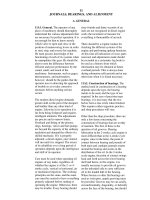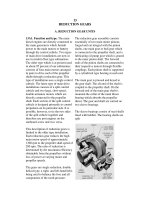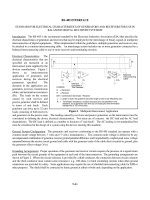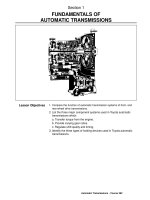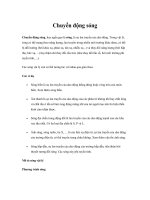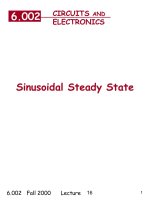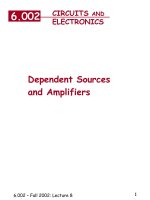Tài liệu Cutting Tools P10 pptx
Bạn đang xem bản rút gọn của tài liệu. Xem và tải ngay bản đầy đủ của tài liệu tại đây (261.28 KB, 9 trang )
Chapter 10
Boring Operations
& Machines
Upcoming Chapters
Metal Removal
Cutting-Tool Materials
Metal Removal Methods
Machinability of Metals
Single Point Machining
Turning Tools and Operations
Turning Methods and Machines
Grooving and Threading
Shaping and Planing
Hole Making Processes
Drills and Drilling Operations
Drilling Methods and Machines
Boring Operations and Machines
Reaming and Tapping
Multi Point Machining
Milling Cutters and Operations
Milling Methods and Machines
Broaches and Broaching
Saws and Sawing
Abrasive Processes
Grinding Wheels and Operations
Grinding Methods and Machines
Lapping and Honing
George Schneider, Jr. CMfgE
Professor Emeritus
Engineering Technology
Lawrence Technological University
Former Chairman
Detroit Chapter ONE
Society of Manufacturing Engineers
Former President
International Excutive Board
Society of Carbide & Tool Engineers
Lawrence Tech. Univ.: http://
www.ltu.edu
Prentice Hall:
10.1 Introduction
Boring, also called Internal Turning, is used to increase the inside diameter of a hole.
The original hole is made with a drill, or it may be a cored hole in a casting. Boring
achieves three things:
Sizing: Boring brings
the hole to the proper
size and finish. A drill
or reamer can only be
used if the desired size
is ‘standard’ or if special
tools are ground. The
boring tool can work to
any diameter and it will
give the required finish
by adjusting speed, feed
and nose radius. Preci-
sion holes can be bored
using micro adjustable
boring bars (Fig. 10.1)
Straightness: Boring
will straighten the original drilled or cast hole. Drills, especially the longer ones,
may wander off- center and cut at a slight angle because of eccentric forces on
the drill, occasional hard spots in the material, or uneven sharpening of the drill
(see Fig. 8.10). Cored holes in castings are almost never completely straight.
The boring tool being moved straight along the ways with the carriage feed will
correct these errors.
Concentricity: Boring will make the hole concentric with the outside diameter
within the limits of the accuracy of the chuck or holding device. For best
concentricity, the turning of the outside diameter and the boring of the inside
diameter is done in one set-up, that is, without moving the work between
operations. The basics discussed in Chapters 4 and 5, the Turning Chapters, also
apply to boring. However, with boring there are a number of limitations that must
be taken into account in order to reach a high stock removal rate combined with
satisfactory accuracy, surface finish and tool life. Therefore, in this chapter the
limitations that distinguish internal turning from external turning will be discussed
in greater detail. A typical boring operation is shown in Figure 10.2.
FIGURE 10.1: Adjustable boring bar for precision holes.
(Courtesy: National Acme Co. Div. DeVlieg-Bullard, Inc.)
2
Tooling & Production/Chapter 10
www.toolingandproduction.com
Chap. 10: Boring Operations & Machines
www.toolingandproduction.com
Chapter 10/Tooling & Production
3
10.2 Boring Operations
Most of the turning operations that
occur with external turning are also to
be found in boring. With external
turning, the length of the workpiece
does not affect the tool overhang and
the size of the tool holder can be chosen
so that it withstands the forces and
stresses that arise during the operation.
However, with internal turning, or bor-
ing, the choice of tool is very much
restricted by the work piece’s hole di-
ameter and length.
A general rule, which applies to
all machining, is to minimize the
tool overhang in order to obtain the
best possible stability and thereby
accuracy. With boring the depth of
the hole determines the overhang.
The stability is increased when a
larger tool diameter is used, but even
then the possibilities are limited
since the space allowed by the
diameter of the hole in the
workpiece must be taken into consid-
eration for chip evacuation and radial
movements.
The limitations with regards to
stability in boring mean that extra
care must be taken with production
planning and preparation. By under-
standing how cutting forces are
affected by the tool geometry and
the cutting data chosen, and also
understanding how various types of
boring bars and tool clamping will
affect the stability, deflection and
vibration can be kept to a minimum.
10.3 Cutting Forces
On engagement, the tangential force
and the radial cutting force will at-
tempt to push the tool away from the
workpiece,
which results
in the deflec-
tions.
The tan-
gential force
will try to
force the
tool down-
wards and
away from
the
centerline.
Due to the
curving of
the internal
hole diam-
eter the
clearance
angle will also be reduced. Therefore
with small diameter holes it is
particularly important that the clear-
ance angle of the insert be sufficient
in order to avoid contact between
the tool and the wall of the hole.
The radial deflection will reduce
the cutting depth. In addition to the
diametrical accuracy being affected,
the chip thickness will change with
the varying size of the cutting
forces. This causes vibration, which
is transferred from the cutting edge
to the tool holder. The stability of
the tool and clamping will be the
factor that determines the magnitude
of the vibration and whether it is
amplified or dampened.
Insert Geometry: The geometry
of the insert has a decisive influence
on the cutting process. A positive
insert has a positive rake angle. The
insert’s edge angle and clearance
angle together will equal less than
90 degrees. A positive rake angle
means a lower tangential cutting
force. However, a positive rake
angle is obtained at the cost of the
clearance angle or the edge angle.
If the clearance angle is small there
is a risk of abrasion between the
tool and workpiece and the friction
can give rise to vibration. In those
cases
where the
rake angle
is large
and the
edge angle
is small, a
sharper
cutting
edge is
obtained. The sharp cutting edge
penetrates the material more easily
but it is also more easily changed or
damaged by edge or other uneven
wear.
Edge wear means that the geom-
etry of the insert is changed,
resulting in a reduction in the
clearance angle. Therefore, with
finish machining it is the required
surface finish of the workpiece that
determines when the insert must be
changed. Generally, the edge wear
should be between .004 and .012
inches for finishing and between
.012 and .040 inches for rough
machining.
Lead Angle: The lead angle
affects the axial and radial directions
of the cutting forces. A small lead
angle produces a large axial cutting
force component while a large lead
angle results in a larger cutting force
in the radial direction. The axial
cutting force has a minimal negative
effect on the operation since the
force is directed along the boring
bar. To avoid vibrations, it is
consequently advantageous to choose
a small lead angle but, since the
lead angle also affects other factors
such as the chip thickness and the
direction of the chip flow, a compro-
mise often has to be made.
The main disadvantage of a small
lead angle is that the cutting forces
are distributed over a shorter section
of the cutting edge than with a large
lead angle. Furthermore, the cutting
edge is exposed to abrupt loading
and unloading when the edge enters
and leaves the workpiece. Since
boring is done in most cases, in a
pre-machined hole and is designated
as light machining, small lead angles
generally do not cause a problem.
Lead angles of 15 degrees or less
are normally recommended. How-
ever, at a lead angle of 15 degrees
the radial cutting force will be
virtually double that of the cutting
force with a 0 degree lead angle. A
FIGURE 10.2: Typical horizontal boring operation. (Courtesy Sandvik
Coromant Co.)
FIGURE 10.3: Typical indexable insert boring bar with 0 deg lead angle.
Chap. 10: Boring Operations & Machines
4
Tooling & Production/Chapter 10
www.toolingandproduction.com
typical indexable insert boring bar
with a 0 degree lead angle is shown
in Figure 10.3.
Nose Radius: The nose radius of
the insert also affects the distribution
of cutting forces. The greater the
nose radius, the greater the radial
and tangential cutting forces, and the
emergence of vibration. However,
this is not the case with radial
cutting forces. The deflection of the
tool in a radial direction is instead
affected by the relationship between
the cutting depth and the size of the
nose radius. If the cutting depth is
smaller than the nose radius, the
radial cutting forces will increase
with increased cutting depth. If the
cutting depth is equal to or greater
than the size of the nose radius, the
radial deflection will be determined
by the lead angle. Therefore, it’s a
good idea to choose a nose radius
which is somewhat smaller than the
cutting depth. In this way the radial
cutting forces can be kept to a
minimum, while utilizing the advan-
tages of the largest possible nose
radius, leading to a stronger cutting
edge, better surface finish and more
even pressure on the cutting edge.
10.4 Chip Breaking and Evacuation
Obtaining relatively short, spiral
shaped chips is the goal in internal
turning. These are easy to evacuate
and do not place such large stresses on
the cutting edge when chip breaking
occurs. Hard breaking of the chips, i.e.
when short chips are obtained, de-
mands power and can increase vibra-
tion in the boring bar. However, this is
preferred over having long chips,
which can make chip evacuation more
difficult. Chip breaking is affected by a
number of factors such as the insert
geometry, nose radius, lead angle, cut-
ting depth, feed and cutting speed.
Generally, reduced feed and/or in-
creased cutting speed results in longer
chips. The shape of the chip breaker
affects the radius of the chip, where
any built-up edge or crater wear can
also act as chip breaker. The direction
in which the chips flow and the way
that they turn in the spiral, is affected
by the lead angle or the combination of
cutting depth and nose radius.
The parameters that affect chip
control also affect the direction and
size of the cutting force. Therefore,
it is necessary to choose a grade and
insert ge-
ometry
that, to-
gether with
the selected
machining
parameters,
fulfill the
require-
ments for
good chip
control. At
the same
time, the
machine,
boring bar
and tool
clamping
must pro-
vide suffi-
cient stabil-
ity in order
to resist the
cutting
forces that
arise.
During boring operations the chip
flow can be critical, particularly
when deep holes are being ma-
chined. The centrifugal force
presses the chips outwards. With
boring, this means that the chips
remain in the workpiece. The
remaining chips could get pressed
into the machined surface or get
jammed and damage the tool.
Therefore, as with internal turning,
tools with an internal cutting fluid
supply are recommended. The chips
will then be flushed out of the hole
effectively. Compressed air can be
used instead of cutting fluid and
with trough holes; the chips can be
blown through the spindle and
collected in a container.
10.5 Boring Rigidity
Part geometries can have external turn-
ing operations as well as internal op-
erations. Internal single point turning
is referred to as boring, and can be
utilized for either a roughing or finish-
ing operation. Single point boring
tools consist of a round shaft with one
insert pocket designed to reach into a
part hole or cavity to remove internal
stock in one or several machine passes.
Figure 10.4 shows various sizes and
styles of boring bars.
The key to productivity in boring
operations is the tool’s rigidity.
Boring bars are often required to
reach long distances into parts to
remove stock (see Fig. 10.5).
Hence, the rigidity of the machining
operation is compromised because
the diameter of the tool is restricted
by the hole size and the need for
added clearance to evacuate chips.
The practical overhang limits for
steel boring bars is four times their
shank diameter. When the tool
overhang exceeds this limit, the
metal removal rate of the boring
operation is compromised signifi-
cantly due to lack of rigidity and the
increased possibility of vibration.
Boring Bar Deflection: The size
of the boring bar’s deflection is
dependent on the bar material, the
diameter, the overhang and size of
the radial and tangential cutting
forces. Boring bar deflection can be
calculated, but such calculations are
beyond the scope of this book.
Increasing the diameter of the tool
to create an increased moment of
inertia can counteract this deflection.
Choosing a boring bar made of a
material that has a higher coefficient
of elasticity can also counteract
deflection. Since steel has a lower
coefficient of elasticity than ce-
mented carbide. Cemented carbide
boring bars are better for large
overhangs.
Compensating for Deflection:
Even with the best tool clamping,
FIGURE 10.4: Various sizes and styles of boring bars. (Courtesy Dorian
Tool)
FIGURE 10.5: Boring bars are often required to reach long distances
into parts to remove stock. (Courtesy Sandvik Coromant Co.)
Chap. 10: Boring Operations & Machines
www.toolingandproduction.com
Chapter 10/Tooling & Production
5
some vibration tendency will occur
in boring. Radial deflection affects
the machined diameter. Tangential
deflection means that the insert tip is
moved in a downward direction
away from the centerline. In both
cases the size and direction of the
cutting forces are affected by
changes in the relationship between
the chip thicknesses and insert
geometry.
If the exact size of the deflection
of the insert tip is known in
advance, then the problem can be
avoided. By positioning the insert
tip distance above the centerline, the
insert under the effect of the
tangential force, will take up the
correct position during machining.
In the same way, setting the machine
at a cutting depth that is greater than
the desired cutting depth compen-
sates for the radial deflection. When
cutting begins, the radial cutting
force reduces the cutting depth.
Even if the approximate deflection
can be calculated, the practical
outcome will be somewhat different
because the clamping is never abso-
lutely rigid and because it is
impossible to calculate the cutting
force exactly.
Boring Bar Clamping: The slight-
est amount of mobility in the fixed
end of the boring bar will lead to
deflection of the tool. The best
stability is obtained with a holder
that completely encases the bar.
This type of holder is available in
two styles: a rigid (Fig. 10.6a) or
flange mounted bar, or a divided
block (Fig. 10.6b) that clamps when
tightened. With a rigidly mounted
bar, the bar is either preshrunk into
the holder and/or welded in. With
flange mounting, a flange with a
through hole is normally used. The
flange is usually glued onto the
shank of the bar at a distance
that gives the required over-
hang. The bar is then fed into
the holder and clamped by
means of a screw connection or
by being held in the turret.
Less efficient are those tool-
clamping methods where the
screw clamps onto the bar.
This form generally results in
vibration and is not recom-
mended. Above all, this
method must not be used for
the clamping of cemented car-
bide bars. Cemented carbide is
more brittle than steel and
cracks will occur as a result of
vibration, which in turn may
result in breakage.
10.6 Boring Bars
Boring bars are made in a wide
variety of styles as shown in Fig-
ure 10.4. Single-point boring
bars (Fig. 10.7) are easily ground
but difficult to adjust when they
are used in turret and automatic
lathes and machining centers, un-
less they are held in an adjustable
holder (Fig. 10.8).
More expensive boring bars
are provided with easily adjust-
able inserts. These bars are
made in standard sizes, with a
range of 1/4 to 1/2 inch on
the diameter. A fine adjustment
is included in increments of
0.001 inch or in some cases
0.0001 inch. They are standard
up to about 6 inches in diam-
eter. A boring bar with
adjustments is shown in Figure
10.9. A different style of
adjustable boring bar with two
indexable inserts is shown in
Figure 10.10.
Standard boring bars with
interchangeable heads to permit
various internal op-
erations such as
turning, profiling,
grooving, and
threading are shown
in Figure 10.11.
Many times it
may be economical
to order special
bars with two or
more preset diam-
eters, set at the
proper distance
apart. These spe-
(a)
(b)
FIGURE 10.6: Two proper boring bar clamping methods.
FIGURE 10.7: Single-point boring bar.
(Courtesy Morse Cutting Tools)
FIGURE 10.8: Adjustable boring head for
single-point boring tools. (Courtesy
Kennametal Inc.)
FIGURE 10.9: Adjustable boring bar with fine-
tuning adjustment. (Courtesy Valenite Inc.)
FIGURE 10.10: Adjustable boring bar with two
indexable inserts. (Courtesy Kennametal Inc.)
FIGURE 10.11: Standard boring bar with
interchangeable heads for various internal
operations such as turning, profiling, grooving,
and threading. (Courtesy Valenite Inc.)
